#special bulletin 1983
Explore tagged Tumblr posts
Text






new (one of my) favorite actors just dropped
#70zcowboyposting#david clennon#the thing#the thing 1982#thingposting#palmer the thing#special bulletin#special bulletin 1983#nurses on the line : crash of flight 7#the escape artist 1982
46 notes
·
View notes
Text
#poll made because i'm a horrorhead and i rarely get scared by horror#but threads (1984) literally gave me nightmares#and war of the worlds (2005) special bulletin (1983) etc genuinely unsettle me#and i've known a few other horror people in the same boat
25 notes
·
View notes
Photo

The documentary film-maker, journalist and author Gavin Weightman, who has died aged 77 after a long-term illness, was one of a number of talented young programme-makers who were recruited in the late 1970s and early 80s to work in the current affairs and features departments of London Weekend Television. As producer and director, Weightman’s outstanding contribution was The Making of Modern London (1983-85), a long-running series that documented the social history of the capital from 1815 to the then present day. What made it stand out was its extensive use of living memory to drive the narrative. Since then, testimony or oral history has become a common feature in documentary TV film-making.
The first series, Heart of the Empire, covered the London of Dickens, Queen Victoria and the Edwardians. In one episode, a 90-year-old Lady Charlotte Bonham Carter recalled the terrible mess horse-drawn traffic made in London’s streets, and how she suffered the indignity of wading through rain-soaked manure to attend a lunch at St James’s Palace. By contrast, Eastender Ted Harrison remembered family “holidays” spent hop-picking in Kent, leaving home at midnight to be there on time. The programmes used extensive archive film, often unearthing unseen footage, innovative rostrum camera work and specially written music to bring each individual memory to life.
Born in Gosforth, Northumberland, Gavin was the son of Doreen (nee Wade), a teacher and translator, and John Weightman, a broadcaster and later professor of French. During the war, John had been the only non-French newsreader for the BBC French Service. The bulletins he delivered sometimes carried coded messages and he often transmitted from the same studios as Charles de Gaulle. Gavin’s love of French food, wine and culture was passed on through his parents. The family lived in West Hampstead, London, but, spending summers near the Northumberland hills, Gavin also learned to love the outdoors and appreciate wildlife.
At primary school Gavin was captain of football and cricket. His secondary education began with a scholarship to Haberdashers’ boys school, Hertfordshire. By all accounts he did not thrive there and left aged 17 to begin a career as a journalist on local papers – first a stint on the Brighton and Evening Argus and then the Richmond and Twickenham Times (or the “Ricky-Twicky Times” as he fondly called it). Half a dozen reporters and editors would be crammed together in a tiny newsroom, all hammering away on 30s-era typewriters amid a dense fug of cigarette smoke. Standing out was Gavin, a tall and decidedly crumpled figure. His old friend the Canadian Broadcasting journalist Brian Stewart recalled Gavin “pouring out copy with ease, offering advice to everyone else on their writing and generally keeping everyone in stitches with gossip”.
After five years on local papers, in 1967 he began a degree course in sociology as a mature student at Bedford College, London University, where he developed a keen interest in social and economic history, especially the Industrial Revolution.
On graduation he spent time working for a newspaper group, writing for local papers. In 1974 he joined the staff of New Society magazine, writing features on a huge range of subjects. He was simply interested in everything – from Industrial Revolution housing to nudist camps in the postwar era and even the history of poaching.
While there, he happened to answer the phone to somebody from LWT current affairs calling to invite another journalist to apply for a job. Gavin took the message, then said, can I apply? He did and got the job, as reporter on The London Programme (1978-82), then, for a year, as its presenter. I was working there as a reporter at the time, and he and I became great friends. His voice was perfect for narration, but getting a man accustomed to a crumpled look to trade up to the suit and tie then required of presenters was always going to be an uphill struggle. What is more, by his own admission, Gavin never really mastered the technique of being able to walk and talk at the same time – another essential for being on screen.
After a brief spell on The Six O’ Clock Show, he gradually devoted more of his time to producing and directing films for the features department. His interest in social history made him the ideal choice to produce, direct and narrate not only the first 12 films of the Making of Modern London series (1983-84) but subsequently two wildlife series – City Safari (1986) and Brave New Wilderness (1990) – and a series on the history of the River Thames (1990), all of which had accompanying books.
When Gavin left LWT in 1991 to set up his own production company, he made more social history programmes for Channel 4, but increasingly concentrated on writing. He wrote more than 20 books ranging from Signor Marconi’s Magic Box (2003) to The Industrial Revolutionaries (2007). His most successful, The Frozen Water Trade (2003), told the history of exporting ice around the world from a frozen Massachusetts lake. It was serialised on Radio 4.
To his many friends Gavin was great company, loved for his ready wit and easy charm. Many a meal round his kitchen table ended with him playing a mean blues on his vintage Gibson guitar.
Gavin’s first marriage, to Myra Wilkins, ended in divorce. He is survived by his second wife, Clare Beaton, a children’s author and illustrator, whom he married in 2009 after a long-term partnership, their son, Tom, his children, Lucie and Ben, from his first marriage, two stepchildren, Jack and Kate, three grandchildren and two great-grandchildren, and his sister, Jane.
🔔 Gavin Weightman, documentary maker, author and journalist, born 4 March 1945; died 18 December 2022
Daily inspiration. Discover more photos at http://justforbooks.tumblr.com
12 notes
·
View notes
Text
78 years since the birth of Fr. Slavko Barbarić
On this day of March 11th, 78 years ago, Fr. Slavko Barbarić was born in the small village of Dragićina in the family of Marko and Luca Barbarić as the fourth of six children.
His family was poor, but hardworking and rich in faith. His father died when little Slavko was 11 years old and this loss hardened him and made him mature early and become responsible. After finishing elementary school with excellent success, he expresses to the parish priest his desire for a priestly vocation and entry into the Franciscan order. He became a seminarian and enrolled at the Episcopal Seminary in Dubrovnik.
From 1966 to 1970, with the termination of military service, Fr. Slavko completed his studies in theology and philosophy in Sarajevo. He graduated in Schwaz, Austria, in 1972, and was ordained a priest on December 19, 1971. He received his Doctorate in Pastoral Theology in Graz in 1973. People's testimonies of the early years of Fr. Slavko's priesthood say that in his work from the beginning he did not limit himself only to the spiritual realm in the narrow sense, but extended his pastoral activity to those limits to which man's needs reached.
He received his first service in Čapljina. The virtues he showed there, such as great work, excellent knowledge of people's spiritual needs, especially closeness and ability to work with young people, did not go unnoticed. The Provincial Administration sends him to postgraduate studies in Freiburg (1978-1982) where he achieves a Doctorate in Religious Pedagogy. The doctoral thesis focused on raising adults in the faith, with the aim of answering the question of how conversion should be taught so that adults could learn and adopt it – just as if he knew that this would be one of the main subjects he would teach at Our Lady's school in Medjugorje! In the meantime, he attends and completes training courses for a psychotherapist and as a certified head of spiritual exercises.
Since January 1982 he has been working in Medjugorje where he worked with pilgrims. During the same period, he wrote reviews, books of spiritual content. He has collaborated with numerous domestic and foreign publications. He was editing the St. Peter's Bulletin. Francis in Čapljina, collaborated in the Karst Homeland, the Voice of Peace and on the radio station "Mir" Medjugorje. Barbarić's books have been translated into twenty languages and printed into millions of copies, making him one of the most widely read writers of our time.
In Mostar, he was a religious teacher for students from the spring of 1982 to September 1984. In Bijele Polje near Mostar, he led prayer seminars with nuns. Since the youth were extraordinaryly accepted by Barbarić's prayer courses and generally fruitful work with young people, the Yugoslav communist government began to persecute Fr. Slavko. These were very difficult times, and he was taken into protection by the exemplary Cardinal Franjo Kuharic so that Fr. Slavko could act.
Due to his knowledge of the main European languages, and in addition to his obligations in the parishes in which he operated, Fr. Slavko has worked tirelessly with pilgrims in Medjugorje in fact since his return from his studies in 1982. He was officially transferred to Medjugorje in 1983. At the request of Bishop Zanic in 1985, he was transferred to the parish of Blagaj, and in 1988 to Humac where he held the post of chaplain and assistant novice teacher.
He led special annual meetings for priests and young people. He led fasting and prayer seminars at the "Domus pacis" provincial house. He founded and ran the "Mother's Village" education and care facility, which he founded because of the great suffering of the war. When the Great Serbian aggression against Bosnia and Herzegovina began, all the older friars went to Tucepi as exiles, but Fr. Slavko remained in Medjugorje, for the oral approval of the provincial at the time + Fr. Drago Tolj.
As a trained psychotherapist, he was able to work with drug addicts in the "Cenacolo" community in their house in Medjugorje "Campo della Vita" and in the community "Merciful Father" which he founded himself in his Mother's Village. He directed the funds sent by benefactors around the world to two funds: the "Fund to the Children of Fallen Veterans in the Homeland War" and the "Friends of Talent Fund" - to help young students.
He spoke tirelessly to the pilgrims. He led prayers before the cross, Eucharistic adorations, the prayer of the Rosary on Podbrdo and the devotion of the Way of the Cross on Križevac, where he ended his earthly life on 24 November 2000.

#love#jesus loves you#jesus christ#blessed mother mary#mary#peace#prayer#medjugorje#father slavko barbaric
0 notes
Text
ANGAKUQ COAT FROM IGLOOLIK
Allison MacDuffee
August 31, 2018
Magazine
Among the works displayed at the National Gallery of Canada is a unique caribou coat with great significance for the Inuit of Igloolik Island, Nunavut. Recreated several decades after an original version of around 1902 and on loan from the Canadian Museum of History, the coat shows consummate sewing expertise. “The indigenous creator had a response that goes beyond the practical garment. It is not just limited to how to stay warm, it is also a means of expression," comments Christine Lalonde, Associate Curator of Indigenous Art. "It is outstanding in one garment to have all necessities for warmth and also an elaborate visual design.”
A shaman (angakuq) and hunter named Qingailisaq was the first owner of the original 1902 coat. His story involves an unforgettable encounter with spirits on the land, but his tale survives in two distinct versions. The first account, told by Qingailisaq himself to the whaling captain George Comer (1858–1937), decribes how he was hunting one day and killed three caribou. The following day, as recorded by the anthropologist Franz Boas in the Bulletin of the American Museum of Natural History in 1907, “he saw four large bucks, one of which was very fat. He struck it with an arrow, and [its] antlers and its skin dropped off, its head became smaller, and soon it assumed the form of a woman with finely made clothes. Soon she fell down, giving birth to a boy, and then she died. The other caribou had turned into men, who told him to cover the woman and the child with moss, so that nobody should ever find them … The men told him to return to his people and to tell them what had happened, and to have his clothing made in the same way as that of the woman.”
Captain George Comer acquired this remarkable clothing directly from Qingailisaq during his whaling voyage to Hudson Bay in 1900–1902 after a request by Franz Boas and the American Museum of Natural History in New York, according to scholar Bernadette Driscoll Engelstad at the Smithsonian's Arctic Studies Center. The coat entered the museum’s collection where it remains to this day.
In 1922 Qingailisaq’s son Awa (or Aua) told a second version of the story to Knud Rasmussen, the Danish polar explorer and anthropologist, who published it in 1929. In this telling, Qingailisaq encountered four mountain spirits while hunting. They suspected the shaman of having killed one of their sons. The shaman succeeded in convincing them of his innocence and they parted “in friendship and mutual understanding”. As Awa recounted, "My father, who was a great shaman, went home and had a dress made like that of the ijeraq, but with a picture of the hands in front, on the chest, to show how the ijeraq had attacked him. It took several women to make that garment, and many caribou skins were used.”
The two different versions of the story share a core message: Qingailisaq had a vivid experience while hunting and was compelled to have a special garment made as a result. But who made the shaman’s clothing? In Awa’s account as told to Rasmussen, “it took several women to make that garment …” Driscoll Engelstad explains, “Although there is a natural presumption that Qingailisaq/Oqamineq's wife would have made the outfit, Awa's statement seems to indicate that this was more of a collective effort.”
In 1983 the Canadian anthropologist Bernard Saladin d’Anglure initiated a project to replicate the shaman’s clothing. Three accurate replicas, produced in partnership with the community in Igloolik, now reside in Laval University Museum, the Canadian Museum of History and the Prince of Wales Northern Heritage Centre in Yellowknife. Jeannie Arnaanuk and family, descendants of Qingailisaq, made the three replicas based on Saladin d'Anglure’s research, and in consultation with Ujuraq, the shaman's grandson. In addition, two further replicas were made: one by Rachel Uyarasuk of Igloolik for the British Museum and another for a private collector.
The Canadian Museum of History’s coat, on view in the NGC's Canadian and Indigenous Galleries, is made of mammal sinew, caribou fur, mammal wool and caribou skin. The front depicts a figure, brown on white, two white hands and three roundels, each with white caribou (puki) thongs. The back has similar roundels and two verticals lines of chevrons.
Inuit clothing is traditionally made by women, who are highly skilled in sewing. They make their own thread from sinew, a natural fiber from caribou tendons that is very strong and swells when wet, filling the needle holes in the fabric and making the clothing water resistant. Lalonde explains the broader skill needed: “There is a contradiction between the need to stay warm and the decoration. When you cut into caribou skin it creates a seam, but Inuit women create a seam that it is wind- and water-proof. This freedom says something about the level of sewing.” Qingailisaq’s original 1902 coat had no hood but came with a specially designed hat and pair of mitts. Driscoll explains that “covering the head and hands was a traditional means of safeguarding the body from contact with spirit forces.”
In recent years, the fashion industry has attempted to appropriate the coat’s design. “The coat has become iconic to a lot of Inuit. The Inuit responded to the incident where designers copied it – even/especially on social media," Christine Lalonde comments. "They were actively concerned and able to respond; they are engaged to respond.”
We will never know exactly what Qingailisaq experienced that day on the land. His transformative vision inspired a unique work of wearable art, as beautiful in technique as it is bold in design.
~~~~~~~~~~~~~~~~~
The Caribou Coat, on loan from the Canadian Museum of History, is currently on view in Gallery A105 of the Canadian and Indigenous Galleries of the National Gallery of Canada. To share this article, please click on the arrow at the top right hand of the page. Subscribe to our newsletters to stay up-to-date on the latest Gallery news, and to learn more about art in Canada.
0 notes
Video
youtube
Special Bulletin (1983)
#this was interesting#stumbled on it on youtube looking for Doomsday 1983#Special Bulletin#Nuclear Disaster#just saying it now kids - it didn't happen#Alternate History
2 notes
·
View notes
Text
Introducing The Wissmanns!
Sorry It Took So Long. Part 1 of 2.
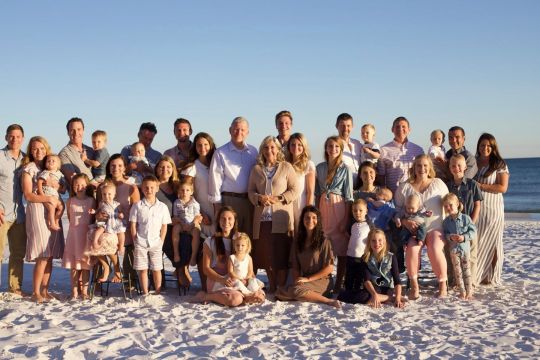
Duggar Data has been tracking the Wissmanns’ Data for quite awhile, and they have officially been a Predictor Family since October 2021. Despite this, I have failed to do a proper Introductory Post... Until now!
Just ahead in Part 1...
Who are the Wissmanns? Where are they from? How many children do they have? How many of their children are married or in relationships? What can you tell me about their specific beliefs or quirks?
Tell Me About Mr. + Mrs. Wissmann.
Headed by Loren Albert + Gloria Ann (Hager) Wissmann, the Wissmann Family hails from Milford, Seward County, NE. Loren owns Wissmann Enterprises—a contracting and roofing company, specializing in “roof coatings,” sandblasting and painting, and excavation at industrial sites and farms. As of 2022, several of the Wissmann Sons—namely Matthias, Stephen, and Nathanael—work with Loren in the family business.
Loren + Gloria married on August 16, 1980, when he was 23, and she was 21. (His DOB is May 15, 1957. Hers is June 6, 1958.) They went on to have a big family—13 Children (8 Daughters, 5 Sons), with no multiple births.
What Are Their Children’s Names / DOBs?
Here’s the full list of names and DOBs, all verified via voter rolls and Nebraska Birth Records—
Rachel Ann (Wissmann) Busenitz January 31, 1982
Ruth Elissa (Wissmann) Bourlier August 16, 1983
Josiah David Wissmann February 23, 1985
Bethany Lynne (Wissmann) Beasley July 10, 1986
Andrew Michael Wissmann February 29, 1988 (Leap Day)
Elizabeth Joy Wissmann September 21, 1989
Matthias Meinert Wissmann June 18, 1991
Stephen Gerald Wissmann July 15, 1993
Hannah Marlys (Wissmann) Duggar June 23, 1995
Susanna Evelyn Wissmann March 7, 1997
Alaythia Gloria Wissmann October 22, 1999
Nathanael Loren Wissmann October 28, 2001
Charissa Marie Wissmann September 25, 2006
Gloria had her Final Child, Charissa, at Age 48.30, giving her 8 Daughters the Latest Fertility Cut–Off of any Predictor Family.
All of the 2nd Generation Wissmanns, except Charissa (#13), are adults. (Her 18th Birthday isn’t until September 25, 2024.) So far, 7 of 13 are married, and an 8th (Nathanael, #12) is in a relationship. All of the married couples—except the newlyweds, Hannah (#9) + Jeremiah—are also parents.
What Church Do The Wissmanns Attend?
According to Free Jinger, the Wissmann Family was once affiliated with Millard Alliance Church (MAC) in Omaha, Nebraska. The Wissmann Family Statement of Faith, posted on their website, strongly substantiates this; it’s identical to the MAC Statement of Faith. Duggar Data also dug up this really old newsletter, in which Andrew Wissmann, then unmarried, is listed as a member of MAC.
However, it appears that the Wissmanns don’t attend MAC anymore. (Unclear when they left.) They are now members of East Fairview Mennonite Church, in Milford, Nebraska. Loren, Matthias, and Stephen all seem to be pretty high up in the church—leading services and bible studies, etc. Church bulletins dating back to February 2016 mention various other Wissmanns, as well.
Are The Wissmanns Quiverfull (QF)?
Yes, Loren + Gloria are absolutely quiverfull (QF). Evidence of this is right on their family website, where Loren + Gloria say—
The Lord used Psalms 127 to open [our] hearts to welcoming children, and Proverbs 22:6 to the awesome responsibility of training the children He would send.
Psalm 127:3–5 is a dog whistle for the QF Movement... It’s their favorite piece of scripture, and the verse that gives the movement its name. It reads—
Lo, children are an heritage of the Lord: and the fruit of the womb is his reward. As arrows are in the hand of a mighty man; so are children of the youth. Happy is the man that hath his quiver full of them....
The Wissmanns also reference Proverbs 22:6, which is another popular Bible verse among the fundamentalist evangelical crowd. It’s the verse about how parents must “train up” their children. (“Train up a child in the way he should go: and when he is old, he will not depart from it.”)
So, yeah... Whether they identify as such or not—and, they probably don’t—Loren + Gloria Wissmann embrace the QF Movement’s core tenets. And, the 2nd Generation Wissmanns aren’t far behind... Rachel frequently tags her IG Posts w/ “#raisingarrows,” for example, and Bethany has posted some pretty quiverfull–y quotes. Also, Ruth recently expressed—“Every birth is a miracle. Every baby a gift.”
Do They Homeschool? Are They IBLP / ATI?
The Wissmanns claim not to be part of IBLP / ATI—but, they do homeschool. (See Also.) (Unclear what curriculum they used.) The 2nd Generation is also homeschooling; Rachel + Alan, Josiah + Abi, and Bethany + Dan are the only ones w/ school age aged children, and they all teach their children at home.
Tell Me A Little More About Their Beliefs.
Modesty. Clearly, it’s important to them, and they prefer that women to wear skirts. They’re not strictly “skirts only,” though. (Gloria doesn’t seem to wear pants, but all of her daughters—including those still living at home—do.) One of the Wissmann In–Laws (Kori) wore a sleeveless wedding dress... Gasp!
Gender Roles. Unfortunately, they’re pretty heavy into gender essentialism... Ruth promotes “healthy femininity” via IG, for example, and posts all sorts of ‘gender matters’ nonsense. (See Also.) Also, Bethany vowed in her wedding vows to “submit to” her husband. There are some glimmers of hope, though—e.g., Susanna Wissmann was allowed to become a pilot.
Courtship. As for relationships, the Wissmanns practice “courtship,” more or less, but don’t seem to call it that. (Ruth referred to “dating” her husband, at one point.) Some of the things they do are a bit courtship–y, though. Rachel and Ruth got engaged within weeks of meeting their husbands, for example, and Rachel waited until engagement to say “I love you.” They don’t seem to kiss until the altar, either.
Are They Friendly w/ Other Predictor Families?
Yes! The Wissmanns are old friends of the Duggars, and are also friendly with fellow Midwestern fundies, the Bontragers (and Bowerses).
Next Up... Part 2 will focus on the 2nd Generation Wissmann Couples.
59 notes
·
View notes
Text
The Rise and Fall of Matrix 1.0 in Shadowrun
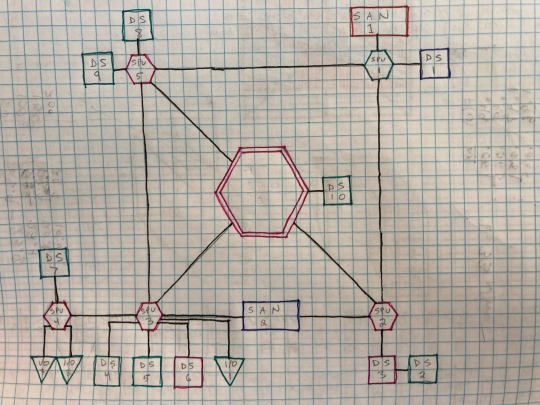
If you know what this is, then we are friends. Hoi chummer.
If you don’t then I’ll first start with what it’s not:

Matrix (mathematics)

John Matrix from Commando
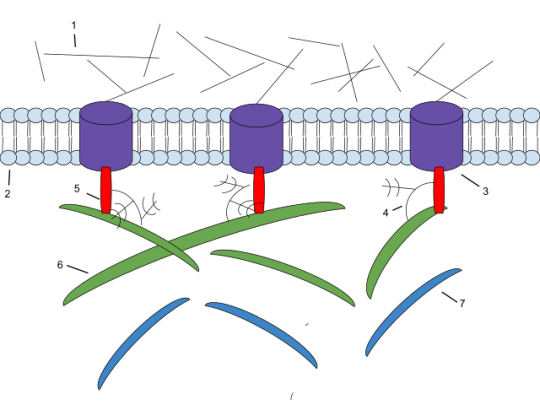
Extracellular matrix
Like most cyberpunk elements within Shadowrun, the use of “matrix” as a virtual-reality driven computer environment derives from William Gibson’s Neuromancer, published in 1984. So yes, Shadowrun rips this off, though not to the infamy that…

…this franchise did.
The Matrix came out in 1999. It was revolutionary in its special effects, realizing Keanu Reeves had a greater range than being Ted, and getting a generation of sci-fi fans to read Baudrillard.
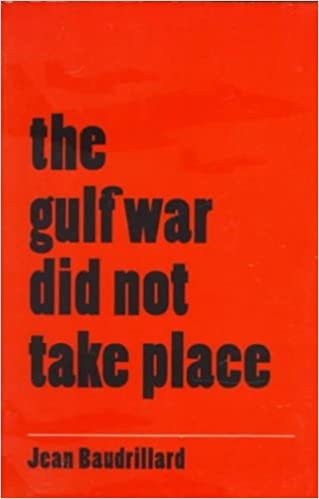
Baudrillard did not write this book.
I’m sure there’s been much written about the central tenet of the movie – that we are living in a simulation – so much so that I’m not bothering to do any research on that topic and get back to the main topic.
Matrix Topology
In college, a group of us Shadowrun nerds tried to recruit a computer-savvy friend to make a character and join our campaign. Naturally, we suggested a decker, and soon had him trying to infiltrate his first system, looking for some mcguffin.txt file that our team was hired to find.
Him: “Well, can’t I just grep it or something?”
Us: “Uhh… that’s not how computers work.”
Him: *already out the door*
The thing to remember about all implementation of computing and hacking in games is that:
It is absolutely nothing like how it works in real life, yet…
…some people will believe it to be chip-truth anyway.
Which is true for every aspect of RPGs – especially combat systems. Sometimes this is amusing – like watching D&D players trying to swing a real sword, and sometimes this leads to the United States Secret Service raiding the offices of Steve Jackson Games over GURPS Cyberpunk.

How can you consider this a threat to the Nation when The World of Synnibarr exists?
The Matrix – in Neuromancer, in the film franchise, in Shadowrun – is built upon telephone networks. In order to connect to a Bulletin Board System (BBS), your computer’s modem (a telephone that speaks computer) had to dial an old-fashioned phone number. Which meant that you had to know what that number is beforehand – there was no equivalent to Google. This is why in the movie WarGames (1983), Ferris Bueller is wardialing – calling every number in an area code to search for the few that connect to computer systems. So much of the presentation in Shadowrun is based upon knowing the address to where you want to go:
Regional Telecommunications Grid (RTG) – this is analogous to country codes. These are letter codes abbreviating the area. The RTG that covers Seattle is NA/UCAS-SEA (North America, United Canadian & American States, Seattle).
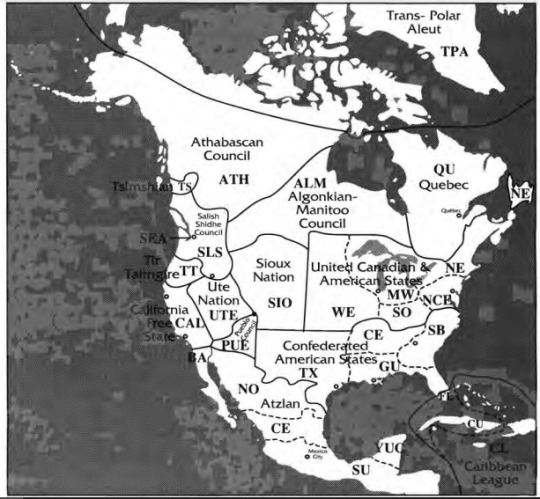
Local Telecommunications Grid (LTG) – this is analogous to a local area code. Every system will have its own LTG, encoded by a number. The examples given all have four digits but presuming there to be more than 10,000 computer systems in Seattle, they could have any value necessary. From the book:
Players should not know what is in the gamemaster's phone book because system owners guard their LTG locations jealously. Player characters will have to hunt down an access code or acquire it during an adventure to know where an LTG system connects. Let them keep their own phone books.
Supposing your decker already has the number, they can try to access the system itself. If connecting from outside (the RTG), then the decker starts off trying to infiltrate the SAN: System Access Node.
Computer systems are constructed out of a network of connected nodes, each of which having a particular purpose, represented by a standard shape, and each actually corresponding to a real part of a computer:
Central Processing Unit (CPU)
Sub-Processing Unit (SPU)
Datastore
Input/Output (I/O) Port
Slave Module

Because the decker (more specifically, the persona program running on their cyberdeck) is intrusive, there are dice rolls involved in gaining illicit access to every node, dice rolls involved in getting the node to execute your commands, dice rolls to deal with the Intrusion Countermeasures (IC, “ice”), and so on.
The Behind the Scenes chapter of the core book gives rules for randomly generating Matrix systems, populating them with ice, and determining the value of any paydata found in datastores.

Which is when you realize that Matrix 1.0 is just a reskinned one-PC dungeon crawl.
A dungeon with locked/stuck doors, monsters to protect them, and treasure to be found in them. It became cliché at our table that when it was time for the decker to do their thing, the rest of the party went to get snacks and shoot some hoops outside. Yes, it was thrilling for the decker, but at the end, they either got they needed from the system, or they didn’t. Unless you were running a campaign of all deckers (which would be AWESOME), you’re better off just having an NPC decker as a contact and contract out that work.
So, it was not surprising that, by the time the 2nd Edition version of Virtual Realities was released, it contained a completely different set of mechanics, dubbed Matrix 2.0, which became the standard when 3rd Edition was published, that greatly streamlined and sped up the gameplay.
16 notes
·
View notes
Photo










Special Bulletin (1983) Dir. Edward Zwick ☆Ed Flanders, Kathryn Walker, Roxanne Hart☆
10 notes
·
View notes
Text
Nemegtonykus citus

By Ripley Cook
Etymology: Nemget Claw
First Described By: Lee et al., 2019
Classification: Dinosauromorpha, Dinosauriformes, Dracohors, Dinosauria, Saurischia, Eusaurischia, Theropoda, Neotheropoda, Averostra, Tetanurae, Orionides, Avetheropoda, Coelurosauria, Tyrannoraptora, Maniraptoromorpha, Maniraptoriformes, Maniraptora, Alvarezsauria, Alvarezsauroidea, Alvarezsauridae, Parvicursorinae
Status: Extinct
Time and Place: 70 million years ago, in the Maastrichtian of the Late Cretaceous


Nemegtonykus is known from the Nemegt Formation of Ömnögovi, Mongolia

Physical Description: Nemegtonykus is known from a partial skeleton, showing a one meter long, lightly built bipedal animal. Like other Alvarezsaurs, it had a long tail and long, thin legs. We don’t know much about its arms or head, but it’s reasonable to suppose it - like other Alvarezsaurs - would have had single thumb claws, and no other digits on its arms; and a small head, ending in a very pointed snout. Parvicursorines, like Nemegtonykus, were of the small and lightly-built vein of Alvarezsaurs - and the apparently much more diverse group - rather than the heavily built Patagonykines. As a small birdie dinosaur, Nemegtonykus would have been covered in feathers, and possibly even had small wing-like feathers on its arms as display structures.
Diet: Alvarezsaur diets is a bit of question - one of the most popular hypotheses is that Alvarezsaurs are insectivores, however there is still a question and they may have been more generalist omnivores.

By José Carlos Cortés
Behavior: Nemegtonykus, as an Alvarezsaur, would have been extremely specialized in speed - its legs were well built for running, both to escape predators and potentially search for prey. It also would have been fairly good at hopping, able to leap out of the way in times of danger or distress. It is possible that the little claws of Nemegtonykus would have been useful in digging up insects or other sources of food out of hard to reach places. Nemegtonykus, like other Alvarezsaurs, would have been a very skittish and anxious animal, using its ability to run to escape danger as quickly as possible. The feathers would have been useful both in thermoregulation (given its small size) and display to other members of the species; and it probably took care of its young to some extent.
Ecosystem: Nemegtonykus lived in the famous and diverse Nemegt Formation, an environment filled to bursting with different kinds of dinosaurs and other prehistoric creatures. This was a vast wetland, flooded with river channels that created extensive lakes, mudflats, and floodplains, much like the modern Okavango Delta in Botswana. This swamp field was surrounded by extensive coniferous forests, where the ground became somewhat drier. This was an area of animals highly specialized for their environment - especially creatures specialized for feeding on water plants, making them all various kinds of vaguely-duck-like animals. There was Duck Satan Deinocheirus, and the ornithomimosaurs Gallimimus and Answerimimus who also had duck-like bills for feeding on soft plants. There was the Hadrosaur (Duck-Billed Dinosaur) Saurolophus, which also fed on soft, mushy plants; and the actual early duck-like thing, Teviornis. In terms of non-duck dinosaurs, there was the large tyrannosaur Tarbosaurus and the smaller Alioramus; Troodontids like Tochisaurus, Zanabazar, and Borogovia; a million kind of chickenparrots like Avimimus, Elmisaurus, Conchoraptor, Nemegtomaia, Nomingia, and Rinchenia; the Hesperornithine Brodavis; Pachycephalosaurs like Homalocephale and Prenocephale; Ankylosaurs such as Tarchia and Saichania; the titanosaur Nemegtosaurus; the Therizinosaur Therizinosaurus; the raptor Adasaurus; and another Alvarezsaur - Mononykus. There was also an Azhdarchid pterosaur, the mammal Buginbaatar, and a variety of crocodilians and turtles.
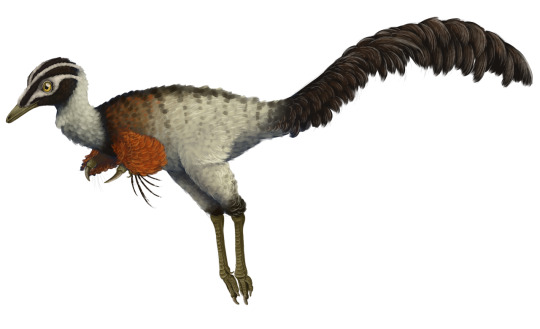
By Scott Reid
Other: Nemegtonykus was found alongside a specimen of Mononykus, potentially indicating that different Alvarezsaurs potentially socialized with each other, or at least didn’t avoid each other within their shared habitats. This may also indicate a level of niche partitioning between different Alvarezsaurs.
~ By Meig Dickson
Sources Under the Cut
Arbour, V. M., Currie, P. J. and Badamgarav, D. (2014), The ankylosaurid dinosaurs of the Upper Cretaceous Baruungoyot and Nemegt formations of Mongolia. Zoological Journal of the Linnean Society, 172: 631–652.
Barsbold, R. (1983). “Carnivorous dinosaurs from the Cretaceous of Mongolia [in Russian].” Trudy, Sovmestnaâ Sovetsko−Mongol’skaâ paleontologičeskaâ èkspediciâ, 19: 1–120.
Chinzorig, T., Kobayashi, Y., Tsogtbaatar, K., Currie, P.J., Takasaki, R., Tanaka, T., Iijima, M., Barsbold, R. 2017. Ornithomimosaurs from the Nemegt Formation of Mongolia: manus morphological variation and diversity. Palaeogeography, Palaeoclimatology, Palaeoecology 494: 91 - 100.
Choiniere, J.N.; Xu, X.; Clark, J.M.; Forster, C.A.; Guo, Y.; Han, F. (2010). "A basal alvarezsauroid theropod from the early Late Jurassic of Xinjiang, China". Science. 327 (5965): 571–574.
Fanti, F., Bell, P.R., Tighe, M., Milan, L.A., Dinelli, E. 2017. Geochemical fingerprinting as a tool for repatriating poached dinoaur fossils in Mongolia: A case study for the Nemegt Locality, Gobi Desert. Palaeogeography, Palaeoclimatology, Palaeoecology 494: 51 - 64.
Fowler DW, Woodward HN, Freedman EA, Larson PL, Horner JR (2011) Reanalysis of “Raptorex kriegsteini”: A Juvenile Tyrannosaurid Dinosaur from Mongolia. PLoS ONE 6(6): e21376.
Funston, G. F.; Mendonca, S. E.; Currie, P. J.; Barsbold, R. (2017). “Oviraptorosaur anatomy, diversity and ecology in the Nemegt Basin”. Palaeogeography, Palaeoclimatology, Palaeoecology.
Gradzinski, R., J. Kazmierczak, J. Lefeld. 1968. Geographical and geological data form the Polish-Mongolian Palaeontological Expeditions. Palaeontologia Polonica 198: 33 - 82.
Holtz, Thomas R., Jr. (2007). "Ornithomimosaurs and Alvarezsaurs". Dinosaurs: The Most Complete, Up-to-Date Encyclopedia for Dinosaur Lovers of All Ages.
Holtz, T.R. 2014. Paleontology: Mystery of the horrible hands solved. Nature 515 (7526): 203 - 205.
Hurum, J. 2001. Lower jaw of Gallimimus bullatus. In Tanke, D. H., K. Carpenter, M. W. Skrepnick. Mesozoic Vertebrate Life. Bloomington: Indiana University Press. 34 - 41.
Jerzykiewicz, T., Russell, D.A. 1991. Late Mesozoic stratigraphy and vertebrates of the Gobi Basin. Cretaceous Reserch 12 (4): 346 - 377.
Kielan-Jaworowska, Z. 1969. Fossils from the Gobi desert. Science Journal 5(1):32-38.
Kielan-Jaworowska, Z., R. Barsbold. 1972. Narrative of the Polish-Mongolian Palaeontological Expeditions 1967-1971. Palaeontologia Polonica 27: 5 - 136.
Kobayashi, Y., Barsbold, R. 2006. Ornithomimids from the Nemegt Formation of Mongolia. Journal of the Paleontological Society of Korea 22 (1): 195 - 207.
Lee, Y.N., Barsbold, R., Currie, P.J., Kobayashi, Y., Lee, H.J. 2013. New specimens of Deinocherus mirificus from the Late Cretaceous of Mongolia. Society of Vertebrate Paleontology Abstracts of Papers: 161.
Lee, Y.N., Barsbold, R., Currie, P.J., Kobayashi, Y., Lee, H.J., Godefroit, P., Escuillie, F.O., Chinzorig, T. 2014. Resolving the long-standing enigmas of a giant ornithomimosaur Deinocheirus mirificus. Nature 515 (7526): 257 - 260.
Lee, S., J.-Y. Park, Y.-N. Lee, S.-H. Kim, J. Lü, R. Barsbold, K. Tsogtbaatar. 2019. A New Alvarezsaurid Dinosaur from the Nemegt Formation of Mongolia. Scientific Reports 9: 15493.
Lü, JC; Xu, L; Chang, HL; Jia, SH; Zhang, JM; Gao, DS; Zhang, YY; Zhang, CJ; Ding, F (2018). "A new alvarezsaurid dinosaur from the Late Cretaceous Qiupa Formation of Luanchuan, Henan Province, central China". China Geology. 1: 28–35.
Newbrey, M. G., Donald B. Brinkman, Dale A. Winkler, Elizabeth A. Freedman, Andrew G. Neuman, Denver W. Fowler and Holly N. Woodward (2013). “Teleost centrum and jaw elements from the Upper Cretaceous Nemegt Formation (Campanian-Maastrichtian) of Mongolia and a re-identification of the fish centrum found with the theropod Raptorex kreigsteini”. In Gloria Arratia; Hans-Peter Schultze; Mark V. H. Wilson (eds.). Mesozoic Fishes 5 – Global Diversity and Evolution. Verlag Dr. Friedrich Pfeil. pp. 291–303.
Schweitzer, Mary Higby, Watt, J.A., Avci, R., Knapp, L., Chiappe, L, Norell, Mark A., Marshall, M. (1999). "Beta-Keratin Specific Immunological reactivity in Feather-Like Structures of the Cretaceous Alvarezsaurid, Shuvuuia deserti Journal of Experimental Biology (Mol Dev Evol) 255:146-157.
Shuvalov, V.F. (2000). “The Cretaceous stratigraphy and palaeobiogeography of Mongolia”. In Benton, Michael J.; Shishkin, Mikhail A.; Unwin, D.M.; Kurochkin, E.N. (eds.). The Age of Dinosaurs in Russia and Mongolia. Cambridge University Press. pp. 256–278.
Takanobu Tsuihiji, Brian Andres, Patrick M. O'connor, Mahito Watabe, Khishigjav Tsogtbaatar & Buuvei Mainbayar (2017) Gigantic pterosaurian remains from the Upper Cretaceous of Mongolia, Journal of Vertebrate Paleontology.
Turner, Alan H.; Pol, Diego; Clarke, Julia A; Erickson, Gregory M.; Norell, Mark (2007). "A basal dromaeosaurid and size evolution preceding avian flight". Science. 317 (5843): 1378–1381.
Watabe, M., S. Suzuki, K. Tsogtbaatar, T. Tsubamoto, M. Saneyoshi. 2010. Report of the HMNS-MPC Joint Paleontological Expedition in 2006. Hayashibara Museum of Natural Sciences Reasearch Bulletin 3:11 - 18.
Watanabe, A., Eugenia Leone Gold, M., Brusatte, S.L., Benson, R.B.J., Choiniere, J., Davidson, A., Norell, M.A., Claessens, L. 2015. Vertebral pneumaticity in the ornithomimosaur Archaeornithomimus (Dinosauria: Theropoda) revealed by computed tomography imaging and reappraisal of axial pneumaticity in ornithomimosuria. PLoS ONE 10 (12): e0145168.
Zelenitsky, D K., F. Therrien, G. M. Erickson, C. L. DeBuhr, Y. Kobayashi, D. A. Eberth, F. Hadfield. 2012. Feathered non-avian dinosaurs from North America provide insight into wing origins. Science 338 (6106): 510 - 514.
#Nemegtonykus#Nemegtonykus citus#Alvarezsaur#Dinosaur#Palaeoblr#Prehistoric Life#prehistory#paleontology#Factfile#Cretaceous#Eurasia#Omnivore#Theropod Thursday#Maniraptoran#dinosaurs#biology#a dinosaur a day#a-dinosaur-a-day#dinosaur of the day#dinosaur-of-the-day#science#nature
237 notes
·
View notes
Text
Internet was WHAT?
Probably a high percentage knows that Internet really expanded between the 1980s and the 1990s, specially thanks to Internet pioneers that decided to come up with new terms such as “cyberspace” or with new acronyms like “MOO” and “MUD” (supposedly might be referred to videogames)

Yes you already knew that, of course. But do you know how Internet actually was? It was the coolest war machine! Kind of...
I will explain myself better trying to wrap up the basic concepts:
Internet started as a small publicly owned computer network established in 1969 in the United States. At the time it was not called how we know it today but it was called internetworking, in fact the term Internet only emerged in 1974 as an abbreviation. The “modern” Internet dates from 1983 with the establishment of a network of networks independent of the US armed forces.
A moment of transition happened when CERN (European Organization for Nuclear Research) adopted internet protocol (IP) for its internal connection and then consequently, in 1989, they opened their first external IP connection.
It’s expansion was also contributed by Globalization which was at its first steps. Naturally, further in the years Internet returned the favor by letting Globalization actually happen.

So, with the internationalisation of the internet, it’s first key applications were e-mails and bulletin boards. And believe it or not, the world wide web (or as we all know it as WWW) publicly launched in 1991. Then of course, the new century saw the rise of social media with the launch of Facebook in 2004 and consequently in 2010, smartphones took off.

But the most absurd part is internet’s technological innovation.
The Internet started as a vast machine that occupied a whole room and turned into a normal object that we can carry around and keep on our laps
Internet went through different developments such as computer networking, shared codes for transporting and addressing communication, and of cloud computing
The Internet became a connective software that facilitated accessing, storage, linking
Internet’s development of communications infrastructure.
Can you believe that Internet did all this in just thirty years? But the most important part was how Internet was at the actual beginning.
Remember when I said that in 1989 CERN opened their first external IP connection? Do you think that’s casual? I don’t think so.
Even though Internet is seen as an agency of peace, it was actually a product of the Cold War.
In 1957, the Soviet Union launched a satellite orbiting the Earth; a factor that was not really appreciated by the Pentagon, which saw this action both as a demonstration but also as a threat. In fact, the Pentagon set up the Advanced Research Projects Agency (ARPA)— a new, independent military body whose aim was to bridge the space gap and to ensure that a technological defeat from the Soviet Union would never happen again. The main idea was also to have one single network in order to maintain all the information together and also to have all different computers around the world function together as a unit. This network was called ARPANET.
Computer networking could facilitate in some way the development of a sophisticated military command and control system that was capable of withstanding a nuclear attack from the Soviet Union. This idea led the military to sponsor a system without a command center that would be destroyed by the enemy in case of attack. This was not a problem because the military also had the idea of a development of network technology that would permit the use of the system even if some parts were destroyed. The military had different concerns because they wanted to have a networking system that could serve different specialized military tasks; in fact, this concern incouraged the creation of a diverse system that allowed different networks to be incorporated.
The military seemed young Tony Starks, huh?
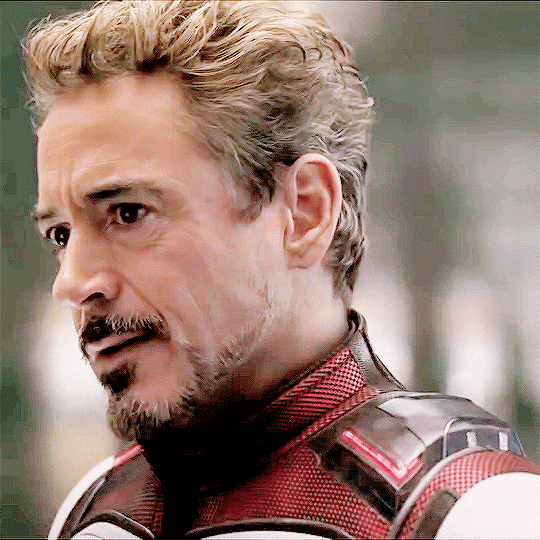
Yes the military did it’s part, but what about other developments?
The military-scientific complex shaped the Internet but also the American counterculture did its part in the 1980s. Basically the counterculture reconceived how the computer could be used to advance its vision of the future. In fact, its activists transformed it from a tool of a techno-elite into a creator of virtual communities, a sub-cultural playground and an agency of democracy.
That’s not it.
A third influence was a European welfarist tradition that created great public health and broadcasting systems. While the internet was born in the US, the world wide web was created by Tim Berners-Lee.

He was inspired by two fundamental ideas:
opening up access to a public good
bringing people into communion with each other
Berners-Lee had the desire not to promote the web through a private company because he thought it might trigger competition and lead the web to be divided into different domains. This would destroy his conception of a universal medium for sharing information.
Now my actual question is: did you really know all THIS? Because I did not.
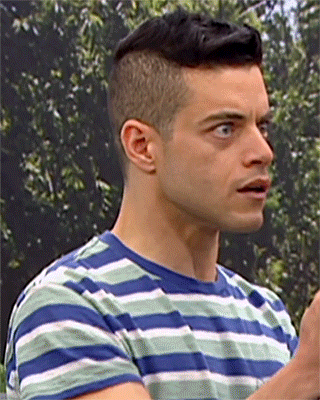
Starting off, it was incredibile how the military thought of a way to use the network in order to keep their data secret but only knowledgeable among the people who actually had to know the facts; in fact there was a contract between the military and scientists in order to keep the situation a secret. We can call that era of internet WEB 1.0 and the one of this era WEB 2.0.
The Internet is a complete different world now, in which you can search things and probably have an opinion, even though at some point you couldn’t have that either, or at least you could give your opinion but it wouldn’t matter.
Unfortunately there is also another kind of web called the dark web, which are networks that use the Internet but require a specific kind of software, configurations and also authorizations to access. Also the internet has its dark side.
With the rise of social media the Internet completely changed. From what was a military experiment, it turned out to be a daily necessity for everyone: from searching important things such as news to also looking for memes or school-related articles. Not to mention also how the internet and social media became a platform that gave access to bullism or actually cyberbullism; apparently with the Internet things can get better but also worse.
If the old Internet could see where the new Internet is at, probably it would tear its hair off.
REFERENCES:
Curran, James. “The Internet of history: rethinking the internet’s past”, in Misunderstanding the Internet
Levine, Yasha. Surveillance Valley: The Secret Military History of the Internet
1 note
·
View note
Text
Astronaut Sally K. Ride's legacy – encouraging young women to embrace science and engineering
by Bonnie J. Dunbar
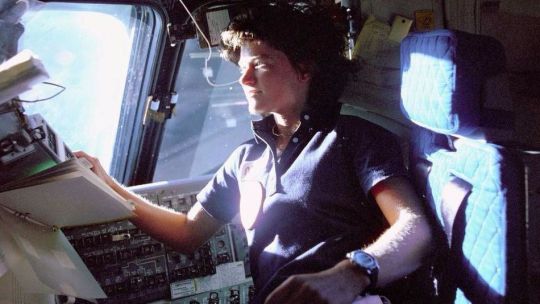
On June 18, 1983, 35 years ago, Sally Ride became the first American woman to launch into space, riding the Space Shuttle STS-7 flight with four other crew members. Only five years earlier, in 1978, she had been selected to the first class of 35 astronauts – including six women – who would fly on the Space Shuttle.

Sally’s first ride, with her STS-7 crewmates. In addition to launching America’s first female astronaut, it was also the first mission with a five-member crew. Front row, left to right: Ride, commander Bob Crippen, pilot Frederick Hauck. Back row, left to right: John Fabian, Norm Thagard. NASA
Much has happened in the intervening years. During the span of three decades, the shuttles flew 135 times carrying hundreds of American and international astronauts into space before they were retired in 2011. The International Space Station began to fly in 1998 and has been continuously occupied since 2001, orbiting the Earth once every 90 minutes. More than 50 women have now flown into space, most of them Americans. One of these women, Dr. Peggy Whitson, became chief of the Astronaut Office and holds the American record for number of hours in space.
The Space Shuttle democratized spaceflight
The Space Shuttle was an amazing flight vehicle: It launched like a rocket into Low Earth Orbit in only eight minutes, and landed softly like a glider after its mission. What is not well known is that the Space Shuttle was an equalizer and enabler, opening up space exploration to a wider population of people from planet Earth.
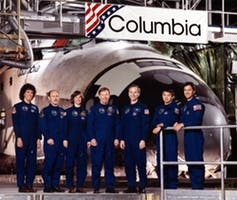
STS-50 Crew photo with commander Richard N. Richards and pilot Kenneth D. Bowersox, mission specialists Bonnie J. Dunbar, Ellen S. Baker and Carl J. Meade, and payload specialists Lawrence J. DeLucas and Eugene H. Trinh. The photo was taken in front of the Columbia Shuttle, which Dunbar helped to build. NASA
This inclusive approach began in 1972 when Congress and the president approved the Space Shuttle budget and contract. Spacesuits, seats and all crew equipment were initially designed for a larger range of sizes to fit all body types, and the waste management system was modified for females. Unlike earlier vehicles, the Space Shuttle could carry up to eight astronauts at a time. It had a design more similar to an airplane than a small capsule, with two decks, sleeping berths, large laboratories and a galley. It also provided privacy.
I graduated with an engineering degree from the University of Washington in 1971 and, by 1976, I was a young engineer working on the first Space Shuttle, Columbia, with Rockwell International at Edwards Air Force Base, in California. I helped to design and produce the thermal protection system – those heat resistant ceramic tiles – which allowed the shuttle to re-enter the Earth’s atmosphere for up to 100 flights.

Mike Anderson and Bonnie Dunbar flew together on STS-89 in 1998. They both graduated from University of Washington. Anderson was killed in the Columbia accident, in 2003. NASA
It was a heady time; a new space vehicle could carry large crews and “cargo,” including space laboratories and the Hubble Space Telescope. The Shuttle also had a robotic arm, which was critical for the assembly of the International Space Station, and an “airlock” for space walks, and enabled us to build the International Space Station.
I knew from my first day at Rockwell that this vehicle had been designed for both men and women. A NASA engineer at the Langley Research Center gave me a very early “heads up” in 1973 that they would eventually select women astronauts for the Space Shuttle. In the 1970s there were visionary men and women in NASA, government and in the general public, who saw a future for more women in science and engineering, and for flying into space. Women were not beating down the door to be included in the Space Shuttle program, we were being invited to be an integral part of a larger grand design for exploring space.
1978: Becoming an astronaut
The selection process for the first class of Space Shuttle astronauts, to include women, opened in 1977. NASA approached the recruitment process with a large and innovative publicity campaign encouraging men and women of all ethnic backgrounds to apply. One of NASA’s recruiters was actress Nichelle Nichols who played Lt. Ohura on the “Star Trek” series, which was popular at the time. Sally learned about NASA’s astronaut recruitment drive through an announcement, possibly on a job bulletin board, somewhere at Stanford University. Sally had been a talented nationally ranked tennis player, but her passion was physics. The opportunity to fly into space intrigued her and looked like a challenge and rewarding career she could embrace.
Sally and I arrived at NASA at the same time in 1978 – she as part of the “TFNG” (“Thirty-Five New Guys”) astronaut class and I as a newly minted mission controller, training to support the Space Shuttle. I had already been in the aerospace industry for several years and had made my choice for “space” at the age of 9 on a cattle ranch in Washington state. I also applied for the 1978 astronaut class, but was not selected until 1980.
Sally and I connected on the Flight Crew Operations co-ed softball team. We both played softball from an early age and were both private pilots, flying our small planes together around southeast Texas. We also often discussed our perspectives on career selection, and how fortunate we were to have teachers and parents and other mentors who encouraged us to study math and science in school – the enabling subjects for becoming an astronaut.
STS-7: June 18 1983

In January 1978, NASA selected six women into the class of 35 new astronauts to fly on the Space Shuttle. From left to right are Shannon W. Lucid, Ph.D., Margaret Rhea Seddon, M.D., Kathryn D. Sullivan, Ph.D., Judith A. Resnik, Ph.D., Anna L. Fisher, M.D., and Sally K. Ride, Ph.D. NASA
Although Sally was one of six women in the 1978 class, she preferred to be considered one of 35 new astronauts – and to be judged by merit, not gender. It was important to all the women that the bar be as high as it was for the men. From an operational and safety point of view, that was also equally important. In an emergency, there are no special allowances for gender or ethnicity: Everyone had to pull their own weight. In fact, it has been said that those first six women were not just qualified, they were more than qualified.
While Sally was honored to be picked as the first woman from her class to fly, she shied away from the limelight. She believed that she flew for all Americans, regardless of gender, but she also understood the expectations on her for being selected “first.” As she flew on STS-7, she paid tribute to those who made it possible for her to be there: to her family and teachers, to those who made and operated the Space Shuttle, to her crewmates, and to all of her astronaut classmates including Dr. Kathy Sullivan, Dr. Rhea Seddon, Dr. Anna Fisher, Dr. Shannon Lucid, and Dr. Judy Resnick (who lost her life on Challenger). With all of the attention, Sally was a gracious “first.” And the launch of STS-7 had a unique celebratory flair. Signs around Kennedy Space Center said “Fly Sally Fly,” and John Denver gave a special concert the night before the launch, not far from the launch pad.
Continuing the momentum
One of the topics that Sally and I discussed frequently was why so few young girls were entering into math, technology, science and engineering – which became known as STEM careers in the late 1990s. Both of us had been encouraged and pushed by male and female mentors and “cheerleaders.” By 1972, companies with federal contracts were actively recruiting women engineers. NASA had opened up spaceflight to women in 1978, and was proud of the fact that they were recruiting and training women as astronauts and employing them in engineering and the sciences.
National needs for STEM talent and supportive employment laws were creating an environment such that if a young woman wished to become an aerospace engineer, a physicist, a chemist, a medical doctor, an astronomer or an astrophysicist, they could. One might have thought that Sally’s legendary flight, and those of other women astronauts over the last 35 years might have inspired a wave of young women (and men) into STEM careers. For example, when Sally flew into space in 1983, a 12-year-old middle school girl back then would now be 47. If she had a daughter, that daughter might be 25. After two generations, we might have expected that there would be large bow wave of young energized women entering into the STEM careers. But this hasn’t happened.
Rather, we have a growing national shortage of engineers and research scientists in this nation, which threatens our prosperity and national security. The numbers of women graduating in engineering grew from 1 percent in 1971 to about 20 percent in 35 years. But women make up 50 percent of the population, so there is room for growth. So what are the “root causes” for this lack of growth?
K-12 STEM education
Many reports have cited deficient K-12 math and science education as contributing to the relatively stagnant graduation rates in STEM careers.
Completing four years of math in high school, as well as physics, chemistry and biology is correlated with later success in science, mathematics and engineering in college. Without this preparation, career options are reduced significantly. Even though I graduated from a small school in rural Washington state, I was able to study algebra, geometry, trigonometry, math analysis, biology, chemistry and physics by the time I graduated. Those were all prerequisites for entry into the University of Washington College of Engineering. Sally had the same preparation before she entered into physics.

As part of NASA’s commitment to the next generation of explorers, NASA Ames collaborated with Sally Ride Science to sponsor and host the Sally Ride Science Festival at the NASA Research Park. Hundreds of San Francisco Bay Area girls, their teachers and parents enjoy a fun-filled interactive exploration of science, technology, engineering and mathematics on Sept. 27, 2008. NASA Ames Research Center / Dominic Hart
Although we have many great K-12 schools in the nation, too many schools now struggle to find qualified mathematics and physics teachers. Inspiring an interest in these topics is also key to retention and success. Being excited about a particular subject matter can keep a student engaged even through the tough times. Participation in “informal science education” at museums and camps is becoming instrumental for recruiting students into STEM careers, especially as teachers struggle to find the time in a cramped curriculum to teach math and science.
Research has shown that middle school is a critical period for young boys and girls to establish their attitudes toward math and science, to acquire fundamental skills that form the basis for progression into algebra, geometry and trigonometry, and to develop positive attitudes toward the pursuit of STEM careers. When Dr. Sally Ride retired from NASA, she understood this, and founded Imaginary Lines and, later, Sally Ride Science, to influence career aspirations for middle school girls. She hosted science camps throughout the nation, exposing young women and their parents to a variety of STEM career options. Sally Ride Science continues its outreach through the University of California at San Diego.
Challenging old stereotypes and honoring Sally’s legacy

Sally Ride and Bonnie Dunbar are fighting outdated stereotypes that women are not good at STEM subjects. Creativa Images/shutterstock.com
However, there are still challenges, especially in this social media-steeped society. I and other practicing women engineers have observed that young girls are often influenced by what they perceive “society thinks” of them.
In a recent discussion with an all-girl robotics team competing at NASA, I asked the high school girls if they had support from teachers and parents, and they all said “yes.” But then, they asked, “Why doesn’t society support us?” I was puzzled and asked them what they meant. They then directed me to the internet where searches on engineering careers returned a story after story of describing “hostile work environments.”
Sadly, most of these stories are very old and are often from studies with very small populations. The positive news, from companies, government, universities and such organizations as the National Academy of Engineers, Physics Girl and Society of Women Engineers, rarely rises to the top of the search results. Currently, companies and laboratories in the U.S. are desperate to employ STEM qualified and inspired women. But many of our young women continue to “opt out.”
Young women are influenced by the media images they see every day. We continue to see decades-old negative stereotypes and poor images of engineers and scientists on television programs and in the movies.
Popular TV celebrities continue to boast on air that they either didn’t like math or struggled with it. Sally Ride Science helps to combat misconceptions and dispel myths by bringing practicing scientists and engineers directly to the students. However, in order to make a more substantial difference, this program and others like it require help from the media organizations. The nation depends upon the technology and science produced by our scientists and engineers, but social media, TV hosts, writers and movie script developers rarely reflect this reality. So it may be, that in addition to K-12 challenges in our educational system, the “outdated stererotypes” portrayed in the media are also discouraging our young women from entering science and engineering careers.
Unlimited opportunities in science and engineering
The reality? More companies than ever are creating family-friendly work environments and competing for female talent. In fact, there is a higher demand from business, government and graduate schools in the U.S. for women engineers and scientists than can be met by the universities.
Both Sally and I had wonderful careers supported by both men and women. NASA was a great work environment and continues to be – the last two astronaut classes have been about 50 percent female.

I think that Sally would be proud of how far the nation has come with respect to women in space, but would also want us to focus on the future challenges for recruiting more women into science and engineering, and to reignite the passion for exploring space.
Bonnie J. Dunbar is a retired NASA astronaut and a TEES Distinguished Research Professor of Aerospace Engineering at Texas A&M University.
This article was originally published on The Conversation, a content partner of Sci Fi Generation.
32 notes
·
View notes
Text
Watch Special Bulletin (1983)
It's on youtube for free and it's such a banger.
3 notes
·
View notes
Text
Bibliography for my term paper on evolutionary studies of homosexuality
A large part of this paper was critiquing how these studies were being done, and that included citing some pretty egregious examples of using out of date and discriminatory language. Some of those words are included in the titles. Please take care of yourself when reading these. A lot of it is interesting, and there are a lot of resources here for producing better, community oriented, respectful research that's applicable across the humanities. But it can get overwhelming. Bailey, J M, and P Bell (Bailey and Bell 1993, 313-322) 1993 Familiality of female and male homosexuality. Behavior genetics 23(4):313–22. DOI:10.1007/BF01067431. Bailey, J. Michael, Michael P. Dunne, and Nicholas G. Martin (Bailey et al 2000, 524-536) 2000 Genetic and environmental influences on sexual orientation and its correlates in an Australian twin sample. Journal of Personality and Social Psychology 78(3):524–536. DOI:10.1037/0022-3514.78.3.524. Bailey, J., RC. Pillard, MC. Neale, and Y. Agyei (Bailey et al 1993, 217-233) 1993 Heritable Factors Influence Sexual Orientation in Women. Arch Gen Psychiatry 50(3):217–223. Barber, Nigel (Barber 1998, 387-401) 1998 Ecological and psychosocial correlaties of male homosexuality. Journal of Cross-Cultural Psychology. 29(3):387-401. Bentler, P M, and P R Abramson (Bentler and Abramson 1981, 225-251) 1981 The science of sex research: some methodological considerations. Archives of sexual behavior 10(3):225–251. DOI:10.1007/BF01543077. Blackwood, E. (Blackwood 1985, 1-17) 1985 Breaking the mirror: the construction of lesbianism and the anthropological discourse on homosexuality. [Review] [74 refs]. Journal of Homosexuality 11(3–4):1–17. DOI:10.1300/J082v11n03. Blanchard, Ray (Blanchard 2012, 551-556) 2012 Fertility in the mothers of firstborn homosexual and heterosexual men. Archives of Sexual Behavior 41(3):551–556. DOI:10.1007/s10508-011-9888-0. Bobrow, David, and J Michael Bailey (Bobrow and Bailey 2001, 361-368) 2001 Is male homosexuality maintained via kin selection ? Evolution and Human Behavior 22:361–368. DOI:10.1016/S1090-5138(01)00074-5. Buhrich, Nell, JM Bailey, and NG Martin (Buhrich et al 1991, 75-96) 1991 Sexual orientation, sexual identity, and sex-dimorphic behaviors in male twins. Behavior Genetics 2(I):75–96. Byne, William, Susan Bradley, Eli Coleman, Evan Eyler, Richard Green, Edgardo J Menvielle, Heino F L Meyer-Bahlburg, Richard R Pleak, and D Andrew Tompkins (Byne et al 2011, 1-35) 2011 Report of the APA Task Force on Gender Identity and Gender Variance. Am J Psychiatry(July 2011):1–35. DOI:10.1037/e516782010-001. Camperio Ciani, Andrea S., Lilybeth Fontanesi, Francesca Iemmola, Elga Giannella, Claudia Ferron, and Luigi Lombardi (Camperio-Ciani et al 2012, 2878-2887) 2012 Factors Associated with Higher Fecundity in Female Maternal Relatives of Homosexual Men. Journal of Sexual Medicine 9(11):2878–2887. DOI:10.1111/j.1743-6109.2012.02785.x. Camperio Ciani, Andrea, and Elena Pellizzari (Camperio-Ciani and Pellizzari 2012) 2012 Fecundity of Paternal and Maternal Non-Parental Female Relatives of Homosexual and Heterosexual Men. PLoS ONE 7(12). DOI:10.1371/journal.pone.0051088. Camperio-Ciani, A., F. Corna, and C. Capiluppi (Camperio-Ciani et al 2004, 2217-2221) 2004 Evidence for maternally inherited factors favouring male homosexuality and promoting female fecundity. Proceedings of the Royal Society B: Biological Sciences 271(1554):2217–2221. DOI:10.1098/rspb.2004.2872. Catania, Joseph A., David R. Gibson, Dale D. Chitwood, and Thomas J. Coates (Catania et al 1990, 339-362) 1990 Methodological problems in AIDS behavioral research: Influences on measurement error and participation bias in studies of sexual behavior. Psychological Bulletin 108(3):339–362. DOI:10.1037/0033-2909.108.3.339. Camperio-Ciani, Andrea, Francesca Iemmola, and Stan R. Blecher (Camperio-Ciani et al 2009, 449-455) 2009 Genetic factors increase fecundity in female maternal relatives of bisexual men as in homosexuals. Journal of Sexual Medicine 6(2):449–455. DOI:10.1111/j.1743-6109.2008.00944.x. Dawood, Khytam, Richard C. Pillard, Christopher Horvath, William Revelle, and J. Michael Bailey (Dawood et al 2000, 155-163) 2000 Familial aspects of male homosexuality. Archives of Sexual Behavior 29(2):155–163. DOI:10.1023/A:1001955721992. Denmark, Florence, Nancy Felipe Russo, Irene Hanson Frieze, and Jeri A Sechzer (Denmark et al 1988, 582-585) 1988 Guidelines for Avoiding Sexism in Psychological Research. American Psychologist 43(7):582–585. Fenton, K. A., A. M. Johnson, S. McManus, and B. Erens (Fenton et al 2001, 84-92) 2001 Measuring sexual behaviour: Methodological challenges in survey research. Sexually Transmitted Infections 77(2):84–92. DOI:10.1136/sti.77.2.84. Forrester, Deanna L., Doug P. Vanderlaan, Jessica L. Parker, and Paul L. Vasey (Forrester et al 2011, 339-352) 2011 Male sexual orientation and avuncularity in Canada: Implications for the Kin selection Hypothesis. Journal of Cognition and Culture 11(3–4):339–352. DOI:10.1163/156853711X591288. Herek, Gregory M., Douglas C. Kimmel, Hortensia Amaro, and Gary B. Melton (Herek et al 1991, 957-963) 1991 Avoiding Heterosexist Bias in Psychological Research. American Psychologist 46(9):957–963. DOI:10.1037/0003-066X.46.9.957. Hershberger, Scott L (Hershberger 2016, 212-222) 2016 A Twin Registry Study of Male and Female Sexual Orientation. The Journal of Sex Research 34(2):212–222. Hoffman, Louis, and Justin Lincoln (Hoffman and Lincoln 2011) 2011 Science, interpretation, and identity in the sexual orientation debate: What does finger length have to do with understanding a person? [References]. PsycCRITIQUES 56(15). DOI:http://dx.doi.org/10.1037/a0023178. Idani, G. (Idani 1991, 83-95) 1991 Social Relationships between Immigrant and Resident Bonobo (Pan paniscus) Females at Wamba. Folia Primatologica 57(2):83–95. DOI:10.1159/000156568. Iemmola, Francesca, and Andrea Camperio Ciani (Iemmola and Camperio-Ciani 2009, 393-399) 2009 New evidence of genetic factors influencing sexual orientation in men: Female fecundity increase in the maternal line. Archives of Sexual Behavior 38(3):393–399. DOI:10.1007/s10508-008-9381-6. Jensen Krige, Eileen (Jensen Krige 2017) 2017 Woman-Marriage, with Special Reference to the Loυedu. Its Significance for the Definition of Marriage. Journal of the International African Institute, Vol . 44, No. 1 44(1). Kirkpatrick, R. C. (Kirkpatrick 2000, 385-413) 2000 The Evolution of Human Homosexual Behavior. Current Anthropology 41(3):385–413. DOI:10.1086/300145. LeVay, Simon (LeVay 1997, 172-193) 1997 Chapter 9 Genes. In Queer science: the use and abuse of research into homosexuality, pp. 172–193. MIT Press, Cambridge, MA Manson, Joseph H, Susan Perry, and Amy R Parish (Manson, Perry, and Parish 1997, 767-786) 1997 Nonconceptive Sexual Behavior in Bonobos and Capuchins. International Journal of Primatology 18(5):767–786. DOI:10.1023/A. Melton, Gary B. (Melton 1989, 933-940) 1989 Public Policy and Private Prejudice Psychology and Law on Gay Rights. American Psychologist 44(6):933–940. DOI:10.1037/0003-066X.44.6.933. Melton, Gary B., Robert J. Levine, Gerald P. Koocher, Robert Rosenthal, and William C. Thompson (Melton et al 1988, 573-581) 1988 Community Consultation in Socially Sensitive Research: Lessons From Clinical Trials of Treatments for AIDS. American Psychologist 43(7):573–581. DOI:10.1037/0003-066X.43.7.573. Morin, Stephen F. (Morin 1977, 35-58) 1977 Heterosexual bias in psychological research on lesbianism and male homosexuality (1979-1983), utilizing the bibliographic and taxonomic system of Morin (1977). Journal of homosexuality 13(1):35–58. DOI:10.1300/J082v13n01_03. Murphy, Timothy F. (Murphy 1998, 1-11) (Murphy 1998, 13-48) 1998 Introduction. In Gay science: the ethics of sexual orientation research, pp. 1–11. Columbia University Press, New York. 1998 Chapter 1 Scientific Accounts of Sexual Orientation. In Gay science: the ethics of sexual orientation research, pp. 13-48. Columbia University Press, New York. Parish, Amy Randall (Parish 1994, 157-179) 1994 Sex and food control in the “uncommon chimpanzee”: How Bonobo females overcome a phylogenetic legacy of male dominance. Ethology and Sociobiology 15(3):157–179. DOI:10.1016/0162-3095(94)90038-8. Rahman, Qazi, Anthony Collins, Martine Morrison, Jennifer Claire Orrells, Khatija Cadinouche, Sherene Greenfield, and Sabina Begum (Rahman et al 2008, 962-969) 2008 Maternal inheritance and familial fecundity factors in male homosexuality. Archives of Sexual Behavior 37(6):962–969. DOI:10.1007/s10508-007-9191-2. Rahman, Qazi, and Matthew S. Hull (Rahman and Hull 2005, 461-467) 2005 An empirical test of the kin selection hypothesis for male homosexuality. Archives of Sexual Behavior 34(4):461–467. DOI:10.1007/s10508-005-4345-6. Rind, Bruce (Rind 2016, 397-407) 2016 Biased Use of Cross-Cultural and Historical Perspectives on Male Homosexuality in Human Sexuality Textbooks. 35(4):397–407. Roscoe, Will (Roscoe 1987, 81-172) 1987 Bibliography of Berdache and Alternative Gender Roles Among North American Indians, Journal of Homosexuality, 14:3-4, 81-172 Schroder, Kerstin E E, Michael P Carey, and Peter A Vanable (Schroder et al 2005, 96-99) 2005 Methodological Challenges in Research on Sexual Risk Behavior: III. Response to Commentary. Annals of Behavioral Medicine 29(2):96–99. Smuts, Barbara, and John M. Watanabe (Smuts and Watanabe 1990, 147-172) 1990 Social relationships and ritualized greetings in adult male baboons (Papio cynocephalus anubis). International Journal of Primatology 11(2):147–172. Strassberg, Donald S., and Kristi Lowe (Strassberg and Lowe 1995, 269-382) 1995 Volunteer bias in sexuality research. Archives of Sexual Behavior 24(4):369–382. DOI:10.1007/BF01541853. Vasey, Paul L (Vasey 1996, 539-551) 1996 Interventions and alliance formation between female Japanese macaques, Macaca fuscata, during homosexual consortships. Animal Behaviour 52(1991):539–551. DOI:10.1006/anbe.1996.0196. Vasey, Paul L., and Doug P. Vanderlaan (Vasey and Vanderlaan 2012, 209-215) 2012 Sexual orientation in men and avuncularity in Japan: Implications for the kin selection hypothesis. Archives of Sexual Behavior 41(1):209–215. DOI:10.1007/s10508-011-9763-z. Williams, Walter (Williams 2001) 2001 Benefits for Nonhomophobic Societies: An Anthropological Perspective. In Ed. Warren Blumenfeld Homophobia: how we all pay the price. Beacon Press, Boston. Wiederman, Michael W. (Wiederman 1999, 59-66) 1999 Volunteer bias in sexuality research using college student participants. Journal of Sex Research 36(1):59–66. DOI:10.1080/00224499909551968. Wilson, Edward O. (Wilson 1975) 1975 Sociobiology: the new synthesis. Belknap Press of Harvard University Press, Cambridge, MA. Wrangham, Richard W. (Wrangham 1993, 47-79) 1993 The evolution of sexuality in chimpanzees and bonobos. Human Nature 4(1):47–79. DOI:10.1007/BF02734089.
5 notes
·
View notes
Text
Special Bulletin (1983)
(more…)
View On WordPress
0 notes
Text
Avenging the Blood of Our Citizens!
By: Lisa Timmerman, Executive Director
Stepping onto a boat and/or ship probably leads to both excitement and some trepidation if you consider the risks of possible accidents or infections (cruise ships). Living in the early 1800s included an additional risk – forcibly serving the British Royal Navy.

(Source: Sword Scabbard Depicting Three Ships in Battle, Presented to Archibald Henderson Fortitudine: Bulletin of the Marine Corps Historical Program, Vol. 34, No. 4, 2009)
Although the War of 1812 did not commence until 1812, the storm was brewing for years prior to America’s formal declaration of war against the British. During the early 1800s, Britain and its’ allies periodically clashed with the French Empire in a series of conflicts known as the Napoleonic Wars as Napoleon I attempted to expand his empire and weaken Great Britain. Although President Thomas Jefferson attempted to keep America neutral, the British and French made this difficult as each power sought any means necessary to stop the other.
Unfortunately for American sailors, Great Britain impressed British men into the Royal Navy, lawfully allowed to do so when Great Britain was at war. The Royal Navy organized press gangs to sweep the streets looking to arrest and press any British man into service with few exceptions (exceptions included: indentured apprentices and any person considered essential to maritime trade – fishermen, shipwrights, and others carrying protection documents). Press gangs also worked at sea and the British frequently stopped American ships looking for British deserters or anyone they could press ignoring legalities. Americans who could not prove their American citizenship suddenly found themselves members of the British Royal Navy, a problem that enraged our country. While the number of actual Americans impressed was probably lower than the contemporary accounts argued, this was one major factor leading to the War of 1812.
Enter three pressed Americans and one pressed British citizen, in June of 1807: William Ware, Daniel Martin, John Strachan, and Jenkins Ratford. After the HMS Leopard patrolled off the coast of Virginia, the four men decided to steal a boat and seek sanctuary with the American frigate USS Chesapeake, safely stowed near Portsmouth, Virginia. While the British demanded the right to search the ship, Commodore James Barron instead conducted his own investigation and ignored the British. Commander of the British North American Station at Halifax, Vice Admiral Berkeley, issued orders to the British fleet to forcibly stop and search the Chesapeake at sea. On 06/22/1807, as the USS Chesapeake sailed by Cape Henry, Captain Salisbury Humphreys of the HMS Leopard attempted one more time to board the ship before firing seven broadsides at close range into the USS Chesapeake. The attack killed three Americans, wounded eighteen, and the four men were taken back to Britain and punished – the Americans jailed, and the British deserter executed.
Outraged, men from Prince William County met at the Dumfries Courthouse on 07/01/1807, issuing a proclamation concerning “…the late indignity offered to the United States of America, by the unprecedented conduct of the commander of the British ship of war Leopard, in the unwarrantable attack…” Alexander Henderson, Richard Brent, Philip Dawe, John Linton, John Macrae, and John Williams resolved, “…That we view with abhorrence the late outrageous attack made upon the flag of our nation, and the wanton murder of our fellow citizens…That we have the utmost confidence in the wisdom and firmness of our executive, and that the proper steps will be pursued by them to redress the national indignity, and procure ample atonement for the blood of our fellow citizens shed on this occasion; and we pledge our lives and fortunes to support the executive in any measure, they may think proper to adopt, to effect this desirable purpose.” Similar declarations rang throughout the country, reminding persons of previous outraged resolves before the Revolutionary War.
Fast forward to the War of 1812 and we find the PWC militia nervously eyeing Dumfries as a realistic target. The Chesapeake Campaign in 1814 (04/23/1813 – 09/14/1814), sought to distract Americans from capturing Canada (yes, we tried to take Canada…it didn’t go well…), and put more direct pressure on American soil. A series of raids in the Chesapeake Bay area eventually led to the British capturing and burning Washington, D.C. on 08/24/1814 – 08/25/1814. Where were the British on 08/22/1814? According to a 1937 report, citing PWC court records, the British were about to take Dumfries. “On 8/22/1814, the British ships were anchored at Quantico, six miles from Grayson’s Hill in Dumfries. It was fully expected that they would attack Dumfries that night. The 36th Regiment of Militia was collecting and the van of the 89th calvary company arrived about noon, but before the arrival of the military the boys of the town had prepared the defense and had formed a Company of “Vigilantes” and from this hill had kept watch of the British ships for hours, and were disappointed that they did not have to use their defense. That afternoon the town was struck by a terrific gale, which is spoken of as the “British Gale”. It did great damage to the town. The British Fleet departed during the storm.”
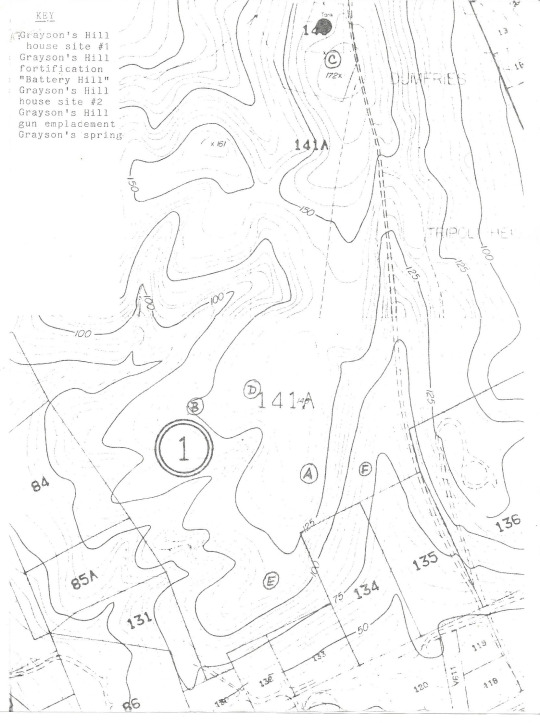
(Source: Fairfax County Archaeological Survey, 1983)
According to Fairfax County Archaeological Surveys conducted in 1983, “Grayson’s Hill” and other associated sites had artifacts ranging from the Revolutionary War to the Civil War, but nothing definitely labeled “War of 1812”. It is interesting to note that on the evening of 08/25/1814, while the British were merrily invading Washington, D.C., a tornado formed after a scorching day of 100F, the storm damaging structures and killing British troops. By 08/27/1814, President James Madison was able to return to the city.
Most of PWC’s militias remained in the county or participated in the Baltimore campaign, with a few detachments sent to Norfolk. In PWC, there were two Regiments – the 36th and 89th, with several units aiding the Northern Neck. Capt. John Brawner of the 89th Regiment proceeded to Mattox Bridge with his unit on 08/05/1814, ultimately reporting to Col. Austin Smith at Round Hill Church in King George County. Capt. Joseph R. Lynn of the 36th Regiment was called out by General John Hungerford and stationed at Fredericksburg and Maddox Bridge from 08/02/1814-09/02/1814. While other local men also captained different regiments stationed in Virginia, Second Lieutenant Archibald Henderson served on the USS Constitution, earning his reputation for bravery and loyalty. Henderson received a brevet promotion to major in August 1814 and was appointed “Lieutenant Colonel Commanding and Commandant” six years later.
Note: Did you let your membership expire during the pandemic? Not a problem – renew today or become a member! Memberships start at $10 (for the entire year) and grant you free face-to-face and virtual tours of The Weems-Botts Museum, a special rental rate for Merchant Park, and discounts to popular programs! Click here to access our online store! Read more about our memberships here!
(Sources: HDVI Archival Files; Gale: 19th Century Newspapers: National Intelligencer, 07/08/1807; The Mariner’s Museum: Prelude to the War of 1812; WPA Historic Survey: Town of Dumfries, 1937; American Battlefield Trust: Chesapeake Campaign – April 23, 1813 to September 14, 1814; Smithsonian Magazine: The Tornado That Saved Washington; National Museum of the Marine Corps: Colonel Archibald Henderson’s Presentation Sword by Beth L. Crumley; Stuart Lee Butler, A Guide to Virginia Militia Units in the War of 1812, Iberian Publishing Company, 1988)
0 notes